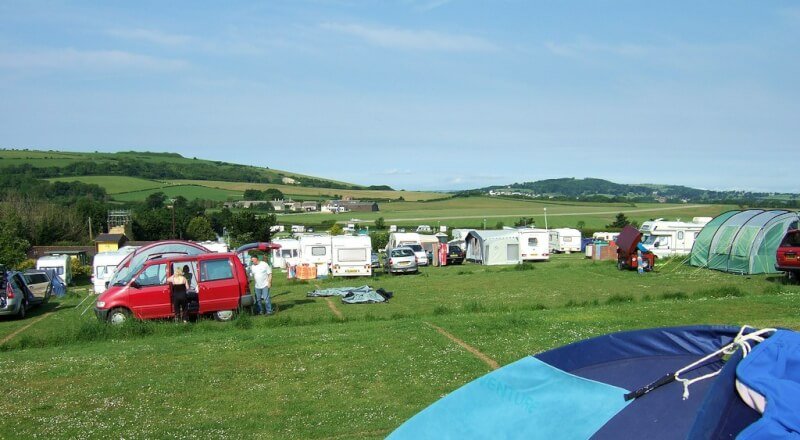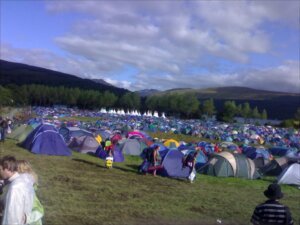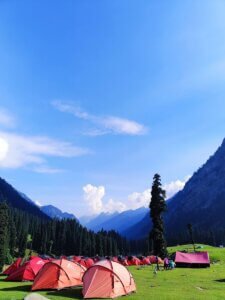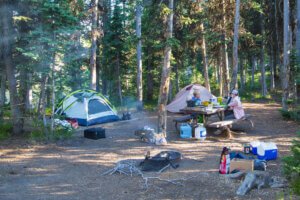Imagine you’re venturing into the great outdoors for the first time, ready to set up your very first campsite. With so many things to consider and prepare, it can feel overwhelming. But fear not, because we’ve got you covered with our top 10 tips for setting up a campsite for beginners. From choosing the perfect location to packing essential gear, we’ll walk you through each step of the process, ensuring your camping experience is a memorable and enjoyable one. So pack your bags, grab your tent, and get ready for an adventure like no other!
Choosing the Right Location
Research the area
When choosing a location for your campsite, it’s important to do your research. Look for campgrounds or designated camping areas that suit your needs. Consider factors such as proximity to amenities, availability of water sources, and any specific regulations or restrictions that may be in place.
Consider accessibility
Accessibility is another crucial factor to consider when selecting a camping location. If you’re new to camping, it’s advisable to choose a site that is easily accessible, especially if you’re planning to carry heavy equipment or have limited mobility. Look for campsites with good road access and close proximity to parking areas.
Look for level ground
A level ground is essential for setting up your tent and ensuring a comfortable sleeping surface. When scouting for a campsite, look for an area that is relatively flat and free from rocks, tree roots, or other obstructions. Avoid areas prone to pooling water or uneven terrain that could cause your tent to slope.
Check for natural shelter
While having a tent provides shelter from the elements, it’s always a bonus to find a location that offers natural shelter as well. Look for campsites with tree canopies or rock formations that can provide shade and protection from winds. This can enhance your camping experience and make it more enjoyable in different weather conditions.
Gathering Essential Equipment
Tent and sleeping bags
A reliable tent and sleeping bags are essential equipment for a successful camping trip. Consider the size of your tent based on the number of people it needs to accommodate and the type of weather conditions you may encounter. Invest in quality sleeping bags that offer adequate insulation and comfort for a good night’s sleep.
Camp stove and cookware
A camp stove and cookware are necessary for preparing meals while camping. Look for a portable stove that is easy to set up and fuel-efficient. Pack sturdy cookware such as a pot, pan, and utensils that are specifically designed for camping. Choose lightweight and compact options to maximize space and ease of transportation.
Flashlights and lanterns
Proper lighting is crucial for navigating your campsite during nighttime. Make sure to bring flashlights and lanterns to illuminate your surroundings and provide visibility inside your tent. Opt for battery-powered options or rechargeable lights for convenience and sustainability. Don’t forget to pack extra batteries or a power bank to ensure you always have enough power.
First aid kit
Safety should always be a top priority when camping. A well-stocked first aid kit is essential for handling minor injuries or emergencies that may occur during your trip. Include items such as bandages, antiseptic wipes, pain relievers, and any necessary medications. Familiarize yourself with the contents of the kit and know how to use them effectively.
Preparing for Different Weather Conditions
Check the weather forecast
Before heading out on your camping trip, always check the weather forecast for the area you’ll be staying in. This will help you prepare for any changes in weather conditions and ensure you bring the appropriate gear and clothing.
Bring appropriate clothing
To stay comfortable and protected, pack clothing suitable for various weather conditions. Include layers that can be easily added or removed as the temperature changes. Bring rain gear, such as waterproof jackets or ponchos, to stay dry in case of rain. Don’t forget to pack warm clothes for cooler evenings and nights.
Pack extra tarps and rope
Tarps and rope can come in handy for creating additional shelter or shielding your campsite from rain or intense sunlight. Pack extra tarps of different sizes and ensure you have enough rope to secure them. This will allow you to adapt your campsite to different weather conditions and enhance your overall camping experience.
Create a windbreak
In windy conditions, setting up a windbreak can make a significant difference in comfort and protect your tent from potential damage. Use tarps, large rocks, or natural windbreaks like trees or bushes to create a barrier. This will help minimize the impact of strong winds on your campsite and make your camping experience more enjoyable.
Setting Up the Tent
Clear the area
Before setting up your tent, clear the area of any debris, rocks, or sharp objects that could damage the tent floor or cause discomfort while sleeping. Clearing the ground will ensure a clean and safe surface for pitching your tent.
Lay a groundsheet or tarp
To protect the bottom of your tent from moisture and prevent wear and tear, it’s advisable to lay a groundsheet or tarp underneath. This extra layer acts as a barrier against dampness and adds an additional level of insulation.
Assemble the tent according to instructions
When assembling your tent, carefully follow the manufacturer’s instructions to ensure a proper setup. Start with the tent poles and gradually build the framework. Once the main structure is in place, attach the tent fabric, rainfly, and any additional components. Double-check all connections and ensure everything is secure.
Secure the tent with stakes and guy lines
To prevent your tent from being affected by wind or shifting ground, use stakes and guy lines to secure it properly. Stake down the corners of the tent and attach guy lines to any provided anchor points. Tension the lines to provide stability and minimize the risk of the tent collapsing or blowing away.
Organizing the Campsite
Designate specific areas
To maintain a well-organized campsite, it’s helpful to designate specific areas for different activities. Set up separate areas for cooking and dining, sleeping, and socializing. This will create structure and make it easier to keep your campsite tidy and functional.
Set up a cooking and dining area
Create a dedicated cooking and dining area where you can prepare meals and enjoy them comfortably. Set up a camping stove or fire pit, along with a table or cooking surface. Keep cooking utensils, pots, and pans within easy reach for convenient meal preparation.
Create a separate sleeping area
Having a designated sleeping area will promote better rest and relaxation. Set up your sleeping bags or air mattresses in a quiet and level portion of the campsite. Consider using a camping hammock for a more comfortable and elevated sleeping option. Arrange your bedding to suit your personal preferences and ensure you have enough space for everyone.
Keep a tidy campsite
Maintaining a clean and tidy campsite is not only aesthetically pleasing but also promotes safety and organization. Keep your equipment, gear, and personal items well-organized and stored away when not in use. Dispose of any trash properly and follow any campground guidelines regarding waste disposal. Regularly clean up any food spills or debris to minimize the risk of attracting unwanted pests.
Building a Fire Ring or Pit
Check local regulations
Before building a fire ring or pit, familiarize yourself with local regulations and restrictions. Some areas may have specific rules in place due to safety concerns or environmental considerations. Follow any guidelines provided by the campground or park authorities to ensure you are using the fire ring or pit appropriately and safely.
Clear the area of any debris
When constructing a fire ring or pit, clear the surrounding area of any flammable debris such as leaves, branches, or dry grass. This helps prevent accidental fires and ensures a safe space for your campfire.
Create a circular ring with rocks
Using rocks, create a circular ring to contain your campfire. Ensure the ring is wide enough to accommodate your fire but not so large that it poses a safety risk. The rocks will help contain the fire and provide a boundary to prevent it from spreading.
Prepare firewood and kindling
Gather an ample supply of firewood and kindling before starting your campfire. Use dry wood and twigs, avoiding green or damp materials that may be difficult to light. Arrange the firewood in a teepee or log cabin shape to promote airflow and efficient burning.
Cooking and Food Safety
Store food properly
Food safety is essential when camping to prevent foodborne illnesses. Store perishable food in a cooler with plenty of ice or ice packs to keep it at a safe temperature. Keep raw meats separate from other food items to avoid cross-contamination. Consider bringing non-perishable food options for convenience and reducing the risk of spoilage.
Keep a clean cooking area
Maintaining a clean cooking area is crucial for food safety and hygiene. Clean and sanitize your cooking utensils, pots, and pans before and after each use. Keep surfaces free from food debris, and promptly dispose of any waste or scraps. Use clean water or sanitizing wipes to wash your hands frequently and prevent contamination.
Practice safe food handling
Follow safe food handling practices to minimize the risk of foodborne illnesses. Cook food thoroughly, especially meats, to kill any harmful bacteria. Use a food thermometer to ensure proper cooking temperatures are reached. Avoid eating unpasteurized or undercooked foods, and properly seal and store leftover food to prevent spoilage.
Dispose of food waste properly
To prevent attracting wildlife or pests, dispose of food waste properly. Follow campground guidelines regarding disposal methods, such as using designated trash cans or bear-proof containers. If no designated options are available, store food waste in sealed bags and carry it out with you when leaving the campsite.
Setting Up Lighting
Use battery-powered lanterns or flashlights
Battery-powered lanterns and flashlights are practical lighting options for your campsite. They provide ample illumination and can be easily moved around as needed. Opt for LED lights to maximize battery life and choose lanterns with adjustable brightness settings for versatility.
Hang lanterns and string lights for ambient lighting
To create a cozy and inviting atmosphere, consider hanging lanterns and string lights around your campsite. These provide ambient lighting and can enhance the overall camping experience. Make sure to secure them properly and avoid placing them near flammable materials.
Consider solar-powered options
For a sustainable and eco-friendly lighting solution, consider using solar-powered lights. These rely on solar panels to recharge during the day and provide illumination at night. Solar-powered lanterns and string lights can be an excellent alternative to traditional battery-powered options, reducing your environmental impact.
Bring extra batteries
To ensure you always have sufficient lighting, bring extra batteries for your lanterns and flashlights. It’s better to be prepared and have backups on hand, especially if you’re camping in a remote location. Check the battery life of all your lights before your trip and replace any batteries that are nearing their end.
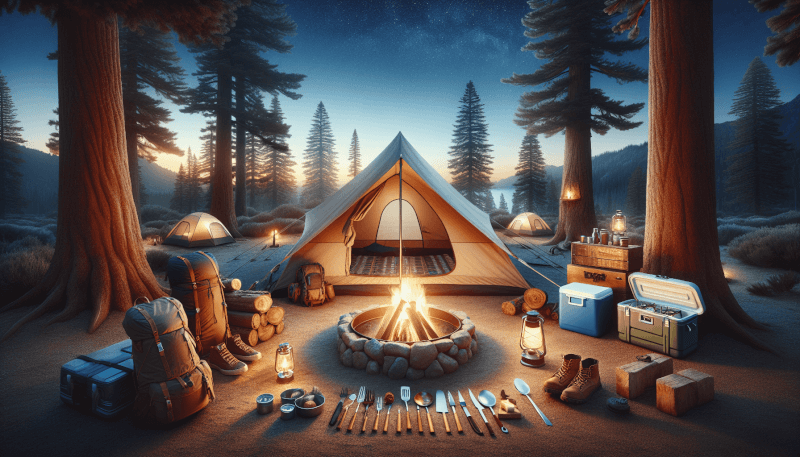
Choosing Comfortable Sleeping Arrangements
Use sleeping pads or air mattresses
For added comfort and insulation, use sleeping pads or inflatable air mattresses. These provide a cushioned surface to sleep on, minimizing discomfort from uneven terrain or rough surfaces. Choose pads or mattresses suitable for camping and consider factors such as insulation, size, and weight when making your selection.
Bring adequate pillows and blankets
To ensure a good night’s sleep, bring pillows and blankets that offer sufficient comfort and warmth. Choose pillows that are portable and easy to clean. Depending on the weather conditions, pack appropriate blankets or sleeping bags that provide adequate insulation.
Consider a camping hammock
An alternative to traditional sleeping arrangements, camping hammocks can provide a unique and comfortable sleeping experience. Hammocks are lightweight, easy to set up, and offer a gentle swinging motion that can aid relaxation. Make sure to choose a hammock designed for camping with proper support and insulation.
Ensure proper ventilation in the tent
Proper ventilation is essential to prevent condensation and maintain a comfortable sleeping environment. When setting up your tent, ensure that vents and windows are open or partially open to promote airflow. This will help reduce humidity and prevent a stuffy or damp atmosphere inside the tent.
Exploring Your Surroundings
Take a map and compass
When camping in unfamiliar surroundings, it’s important to have navigational tools such as a map and compass. Familiarize yourself with the area and plan your hikes or exploration routes in advance. Use the map and compass to navigate trails and avoid getting lost.
Ask locals for recommendations
Locals often have insider knowledge of the best spots and attractions in the area. Don’t hesitate to ask for recommendations or advice on nearby hiking trails, scenic viewpoints, or must-visit locations. They may suggest hidden gems or lesser-known areas that will make your camping experience more memorable.
Go hiking and explore nearby trails
Camping provides an excellent opportunity to connect with nature and get active. Take advantage of the surrounding trails and go hiking to explore the natural beauty of the area. Research the difficulty level and length of the trails before embarking on any hikes to ensure they are suitable for your fitness level and time constraints.
Learn about local flora and fauna
Make the most of your camping experience by learning about the local flora and fauna. Research or ask locals about the native plants and animals in the area to enhance your understanding and appreciation of the ecosystem. Practice responsible nature observation and avoid disturbing or harming any wildlife or vegetation.
In conclusion, setting up a campsite for beginners involves careful consideration of various factors, from choosing the right location to organizing the campsite and preparing for different weather conditions. By following the tips outlined in this article, you can ensure a safe, comfortable, and enjoyable camping experience. Remember to prioritize safety, respect the environment, and have fun exploring the great outdoors. Happy camping!


